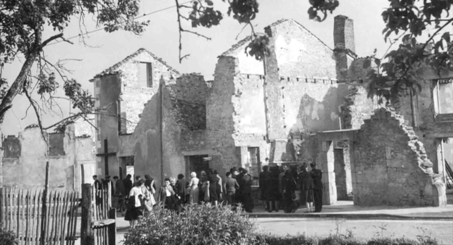WR, A Day in Oradour: interview with Patrick Séraudie
Patrick Séraudie, a filmmaker specializing in history subjects, and the Second World War in particular, made the documentary “WR, A Day in Oradour” with Willy Ronis. A conversation about the photographer’s memories and the international history of the “Peace Movement”. Patrick Séraudie first met the photographer while preparing the film Self-portrait of a Photographer, of which he was the producer.
***
Emmanuel Bacquet: Patrick Séraudie, how did you meet Willy Ronis?
Patrick Séraudie: I met Willy Ronis in the last ten years of his life, when we were working on Michel Toutain’s film Self-portrait of a Photographer. That was in 1998. Willy died in 2009. I then met him on several occasions in 2006 while shooting the sequences on Oradour.
EB: I imagine he was a joy to work with?
PS: Yes, he was just like his photographs: loveable, deeply humanist, and what I especially liked – even though he was 90 years old when I met him – was that he was so curious about, so interested in everything. He went to the cinema on a regular basis and we often talked about it.
EB: I was struck by the quality of his language. It’s very poetic, very clear.
PS: You’re right, his language is from another age! But with this language, he discussed his photos, and in such incredible detail too. He could recall the date, the people and the circumstances of every single picture. It was astounding.
EB: How did you come to meet him?
PS: The first time was for the Self-portrait of a Photographer project. We’d just completed a portrait of the photographer Raoul Haussmann and we were looking for other photographers. The storyteller Georges Chatain, who’d got to know him when they worked together, suggested Willy Ronis. It then took us four or five years to actually make the film.
While we were working on it, I was also busy working on Oradour and its memory. I had already made a first film that had been released at the cinema: Une vie avec Oradour (A Life with Oradour).
I was familiar with the photos Willy had taken in Oradour in 1949, when the “Peace Caravan” with Louis Aragon and the whole gang stopped off there.
I talked to him about those photos all the time. To him, they represented a single day - June 12th, 1949 - whereas I find the photos remarkable because they tell us about the village after the massacre and how ruins can become a political issue and a memory issue.
The “Peace Movement” ceremony was actually held two days after the official commemoration of the massacre, on the initiative of the French Communist Party as the mayor at the time was communist.
EB: Is photography a powerful tool of remembrance?
PS: The marvellous thing about the photos that I asked him to dig out was that rather than simply photographing the ruins as so many people had done, he took a different approach.
He did what he had always done: while working on assignments as a journalist, he’d take the liberty of shooting more personal pictures.
He is one of the only photographers I know to have wandered off the official route with his camera, to photograph the residents in the temporary housing that was erected while the new town was being built
This housing had been photographed in a clinical manner, from an architectural perspective, during its construction, but he went to photograph the people outside and inside their temporary homes.
EB: Willy Ronis was anything but cold.
PS: Yes, and I really liked his approach, such as when he took that famous photograph of Rose Zehner. He explained how he had opened a door and happened across that scene (Editor’s note: During the metalworkers’ strike in 1938) then closed the door because he felt he shouldn’t be there.
This approach of his involved carrying out his assignments and looking for more personal things behind closed doors whenever possible.
EB: He had hard times too, lean periods.
PS: Absolutely. I think he had a low point in the ‘70s and ‘80s. It’s one of the reasons he moved to Provence. Life was tough in Paris.
EB: What place does photography have in your life? Have you worked on other photography projects?
PS: I’m very much an amateur photographer but in the films I make on history, memory, the transmission of memory, I often use photos, particularly of the Second World War.
As a producer at Pyramide Productions, I wanted to develop projects on artists, portraits of artists. At the very start of my career, I had begun a portrait of a travelling photographer.
Then there was the film on the German Dadaist Raoul Haussman, then Ronis, then Clergue, as well as a film on Guy Le Querrec.
I met Sabine Weiss around the same time as I met Ronis. Unfortunately we never did her portrait.
I had also started producing a film by a Hungarian filmmaker about Kertesz. It’s one of my great regrets that the project was never completed because he is one of my favourite photographers.
EB: It isn’t too late to make a film about Sabine Weiss!
PS: I know. The fact is, I’ve moved on to other things now. But I spent over fifteen years working on photography and it’s something I love.
Interview conducted in October 2021


